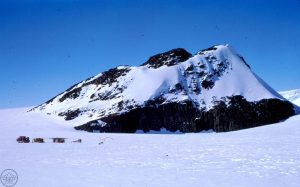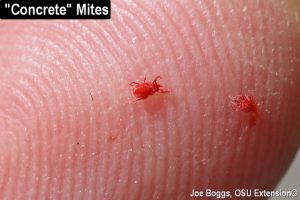Podcast: Play in new window | Download (Duration: 9:37 — 9.8MB)
Thanks to Ella for this week’s suggestion. There may not technically be spiders in the Antarctic, but there are mites.
A nunatak (note the size of the research vehicles at the bottom left):

I don’t have any pictures of the Antarctic mites, so here are some red velvet mites, although they’re giants compared to their Antarctic cousins:

Show transcript:
Welcome to Strange Animals Podcast. I’m your host, Kate Shaw.
This week we’re going to have a short episode, because I get my second Covid-19 vaccine on the Thursday before this episode goes live and I want to have the episode all finished before then. That way if I feel bad afterwards I can rest. Thanks to Ella for this week’s suggestion!
Back in episode 90, about some mystery spiders, I mentioned that spiders live everywhere in the world except Antarctica. Well, guess what. Ella sent me some links about spiders that live in…Antarctica!
Antarctica is a landmass at the South Pole, specifically a continent about twice the size of Australia. It looks bigger than it really is because ice projects out from the land and is only supported by water, called an ice shelf. It’s not a little bit of ice, either. It’s over a mile thick, or nearly 2 km. The ice is called the Antarctic ice sheet and it covers 98% of the continent. The only places not covered in ice are some rock outcroppings and a few valleys, called dry valleys because they basically get no precipitation, not even snow and certainly not rain. Researchers estimate that it hasn’t rained in these dry valleys in almost two million years. There are no plants, just gravel. There are no animals but some bacterial life that live inside rocks and under at least one glacier. Scientists have used these dry valleys to test equipment designed for Mars. This is not a hospitable land. Everything that lives in Antarctica is considered an extremophile.
That doesn’t mean there’s no life in Antarctica, though, just that it’s only found in a few places, mostly along the coast or on nearby islands. Emperor penguins and Adelie penguins, several species of seal, and some sea birds live at least part of their lives in and around Antarctica, as do some whales. There are lichens, algae, and a few low-growing plants like liverwort and moss. And there are some invertebrates, although not very many and not large at all. The largest is a flightless midge that only grows 6 mm long. But what we’re interested in today are mites found only in Antarctica.
We talked about mites in episode 186 when we learned about the red velvet mite. Mites are arachnids, although they’re not technically spiders, but frankly we’re just quibbling at this point. It has eight legs and is in the class Arachnida, so I say there are spiders in Antarctica. Or close enough.
There are 30 species of mite in Antarctica. They mostly live on islands throughout the Antarctic peninsula, which sticks out from one side of the continent like a tail pointing at the very tip of South America. All the mites eat moss, algae, and decomposing lichens. They’re also teeny-tiny, less than a millimeter long.
One type of mite is found on the mainland of East Antarctica instead of just on islands. It’s called Maudheimia and it only lives on big rock outcroppings that stick up through the ice. These rocks are called nunataks and are covered with lichens. But nunataks are far apart, sometimes hundreds of miles apart, and the mites are so tiny they’re just about microscopic. How did they get from one nunatak to the next?
To find out, we have to learn some history about Antarctica. It hasn’t always been at the South Pole. It was once part of the supercontinent Gondwana, and 500 million years ago it was right smack on the equator. You know, tropical. As the centuries passed and the continents continued their slow, constant dance around the Earth, Gondwana drifted southward and broke apart. Antarctica was still connected to Australia on one side and South America on the other, and was still subtropical. Then it broke off from Australia around 40 million years ago, drifted farther southward, and ultimately, about 25 million years ago, separated from South America. Ever since it’s been isolated at the South Pole, and by 15 million years ago it was ice-covered.
Fossils of dinosaurs and other ancient animals have been discovered in Antarctica, but it’s hard to find fossils and excavate them when the ground is under a mile of ice. The animals and plants that once lived in Antarctica went extinct gradually as its climate became less and less hospitable, and most of the remaining holdouts went extinct when the ice age began and the continent’s climate was even colder and harsher than it is now.
But one animal remains, toughing it out on rock outcroppings where the temperature can drop to -31 degrees Fahrenheit, or -35 Celsius. Maudheimia, the brave little mite.
Maudheimia was probably common throughout Antarctica’s mountains before the big freeze happened, and would have already been well adapted to the cold of high elevations. As the continent grew colder and colder, the little mite adapted even more. The fluids in its body contain an organic antifreeze agent so it doesn’t freeze solid. As the ice covered more of its home, it migrated, in its tiny way, to the rocks that stayed ice-free and allowed lichen to survive too. It’s reasonably common despite its restricted habitat, which is good because the female Maudheimia only lays one egg every year or two. There are four species known.
Maudheimia probably isn’t the only animal that survived Antarctica’s ice age, though. Species of springtail only found in Antarctica live alongside Maudheimia, and there are tardigrades and tiny nematode worms around too. All these were probably around long before the end of the ice age around 12,000 years ago.
There may be other microscopic or nearly microscopic animals we haven’t discovered yet. The Antarctic is the only place in the world that humans have never colonized, although a small number of people live in scientific outposts while conducting research of various kinds. There’s a lot we don’t know about the continent.
For instance, there are at least 400 subglacial lakes in Antarctica. The lakes form between the bedrock and the ice sheet, like a little bubble of water. Iceland, Greenland, and Canada have some too. They’re hard to study, naturally, because it requires drilling through over a mile of ice to get a water sample. So far researchers have discovered extremophile microbes in these lakes, but so few samples have been taken that we certainly don’t know everything that’s down there. Most of the lakes occasionally overflow into nearby subglacial lakes, but at least some appear to have been isolated under the ice for potentially millions of years. They may contain bacteria and other microbial life that are radically different from modern species.
There’s one other place that we know has a subglacial lake, discovered in 2018. It’s on the planet Mars. I wonder if there’s anything living in that one.
You can find Strange Animals Podcast at strangeanimalspodcast.blubrry.net. That’s blueberry without any E’s. If you have questions, comments, or suggestions for future episodes, email us at strangeanimalspodcast@gmail.com. If you like the podcast and want to help us out, leave us a rating and review on Apple Podcasts or Podchaser, or just tell a friend. We also have a Patreon at patreon.com/strangeanimalspodcast if you’d like to support us that way.
Thanks for listening!